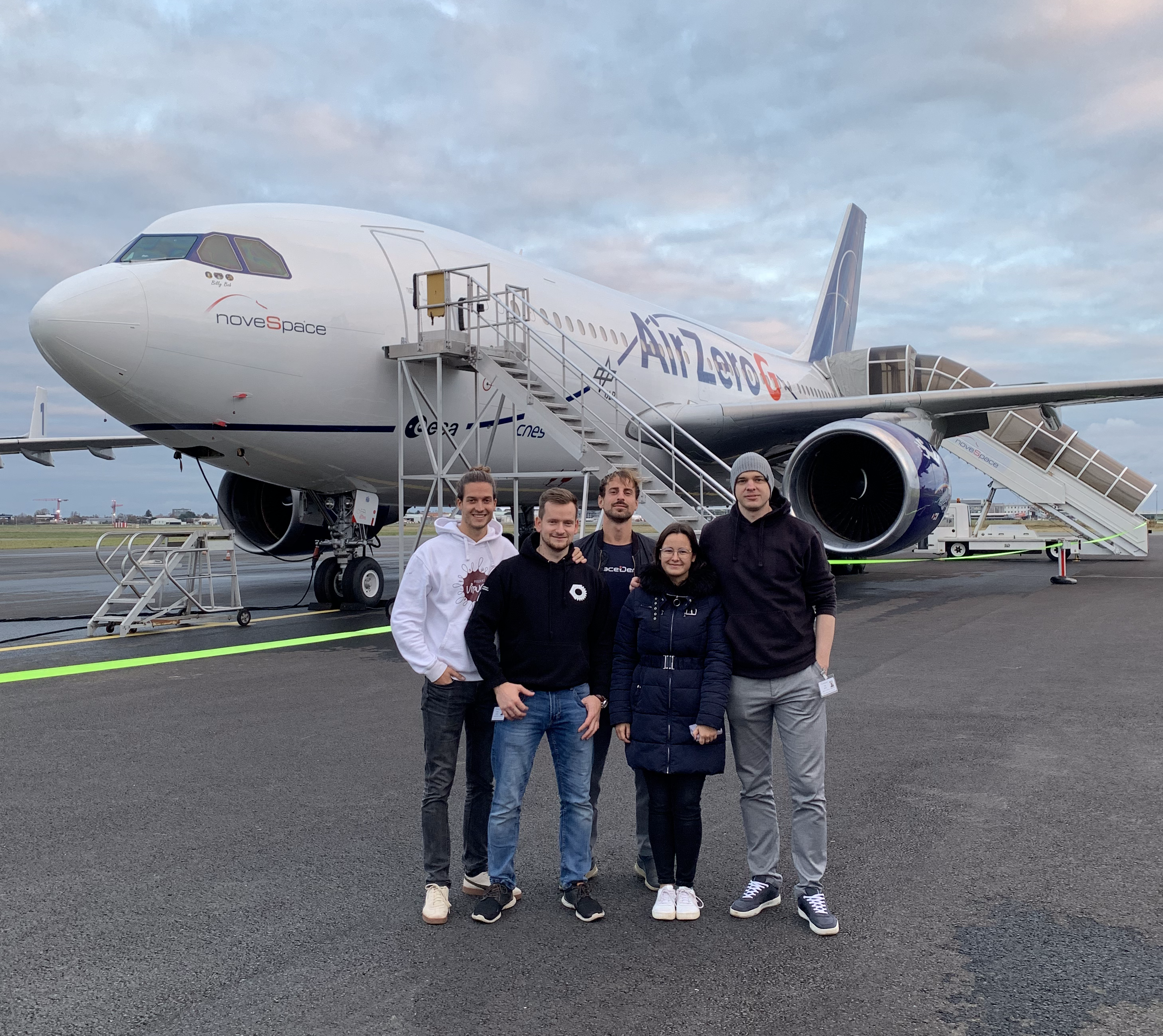The results of the study will provide a baseline for evaluating and optimising dental procedures for safe and effective dental care on long-duration missions to the Moon and Mars.
The SpaceDent project, entitled “Effect of simulated microgravity on the accuracy of dental restorations“, has enabled dental, mechanical and electrical engineering students to carry out research in micro- and hyper-gravity. The students carried out their experimental work between 20 November 2023 and 1 December 2023 in Bordeaux, France. During parabolic flights and microgravity, they performed dental procedures in simulated weightlessness. The aim of the study is to determine whether the ability to handle dental instruments in microgravity is sufficiently controlled for safe dental treatment of astronauts.
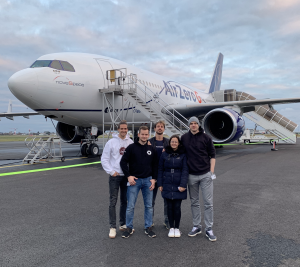
Photo: archive SpaceDent
Over the Atlantic, the students flew three parabolic flights of 93 parabolas, giving them 30 minutes of weightlessness. The parabolas consist of intervals of microgravity and hypergravity, with periods of stable flight in between. Work on the research samples was carried out during 22-second intervals of microgravity, while work on the control teeth was carried out during periods of stable flight and when the aircraft was stationary on the ground. During the first and second flights, the dental students used a dental drill to remove the colour-coded decay areas from the plastic teeth during 22 microgravity intervals. During the third flight, 22 microgravity intervals were used to fill the pre-prepared cavities of the artificial teeth with filling materials.
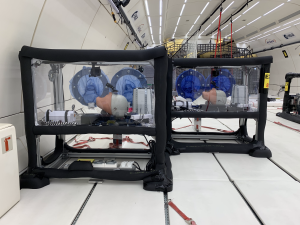
Photo: archive SpaceDent
72 specimens of prepared teeth and 36 specimens of filled teeth were obtained from the microgravity, stable flight, and stationary phases of the Airbus A310 Zero-G aircraft. These will be scanned and imaged over the next few days using an intraoral scanner and compared with the baseline images taken before they left for France. This is followed by threshold segmentation image analysis to measure the area of under- and over-prepared carious lesions and the volume of over- and under-filled spaces of dental fillings. Finally, they will compare the parameter values obtained in microgravity, in stable flight to the nearest tenth of a millimetre, and on the ground, and publish the results.
The research was carried out without any major complication During the parabolic flights, the students experienced periods of hyper- and micro-gravity without discomfort and were able to work through the entire weightlessness period. They were pleasantly surprised by the ease of controlling the instruments in weightlessness, but despite promising beginnings, the results of the research will have to wait.
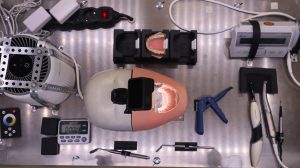
Photo: archive Peskovnik (UL, Faculty of Mechanical Engineering)
The results, which are expected to be published in March 2024, will be deposited in the European Space Agency’s HREDA archive and scientific publications, marking the end of the SpaceDent project. The results, which are expected to be published in March 2024, will be deposited in the European Space Agency’s HREDA archive, and presented in scientific publications, marking the end of the SpaceDent project.
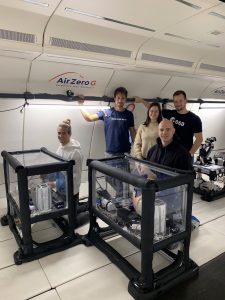
Photo: archive SpaceDent
The SpaceDent team
SpaceDent is an interdisciplinary student research group consisting of dental, mechanical and electrical engineering students participating in the European Space Agency’s (ESA) Academy Experiments programme. The project was launched on the initiative of the students (see the list of students at the end of this press release) and with the support of prof. dr. Janja Jan, Vice Dean of the Department of Dental Medicine, mentor prof. dr. Aleš Fidler, prof. dr. Igor Švab, Dean of the Faculty of Medicine and comentor doc. dr. Simon Oman, Associate Professor at the Faculty of Mechanical Engineering, University of Ljubljana. Professional, financial and material support was provided by UL’s Faculty of Medicine and Faculty of Mechanical Engineering. After being accepted in a call from the European Space Agency, the students were given the opportunity to use the Peskovnik – Open Laboratory of the Faculty of Mechanical Engineering, where a construction was built to simulate a simplified environment of a dental clinic.
Structure adapted to parabolic flight – Peskovnik
To carry out the research, mechanical engineering students and an electrical engineering student built a structure adapted to parabolic flight in Peskovnik, an open laboratory at UL’s Faculty of Mechanical Engineering, which represents a simplified environment of a dental clinic. The construction of the structure includes the creation of an isolated research space with dental instruments, the installation of electrical and filtration systems, adaptation to the changing gravity environment of the parabolas and compliance with aerospace industry standards. In the structure, dental students performed dental procedures on heads from the Faculty of Medicine’s Clinical Dental Skills Learning Centre.
The initiator and project head is Tine Šefic, a dental student, who was responsible for the preparation of the project in Slovenia and its implementation in France. As a researcher, he performed simulated dental services during a parabolic flight.
Prof. dr. Sekavčnik Mihael, Dean of the Faculty of Mechanical Engineering, emphasised that “pushing the boundaries of the known begins with an idea, and in the pursuit of each idea, new ideas are born; creativity knows no boundaries, it goes beyond the sky to the constellations. Literally – that’s the ambition of the SpaceDent project, which we at the Faculty of Mechanical Engineering have supported with open arms and opened the doors of our open laboratory, Peskovnik. This is where we work, learn, and collaborate per aspera ad astra. This is where students from different UL faculties make their way to the stars.”
The following are taking part in the project:
Faculty of Medicine UL, Department of Dental Medicine
- Graduates: Tine Šefic, Rok Gerbec, Tomaž Škapin
- Mentor: prof. dr. Aleš Fidler
Faculty of Mechanical Engineering UL
- Students: Mitja Dergan, Hana Prtenjak, Tomi Štucin, Tomaž Tomšič
- Co-mentor: doc. dr. Simon Oman
Faculty of Electrical Engineering UL
- Student: Matic Hvala
More information about the research project can be found at the following links:
- spacedentproject.com
- Instagram: https://www.instagram.com/spacedentproject/
- Facebook: https://www.facebook.com/spacedentproject
- YouTube: https://www.youtube.com/@spacedentproject
- Presentation video (informative): https://www.youtube.com/watch?v=CgEHNZMExyg
